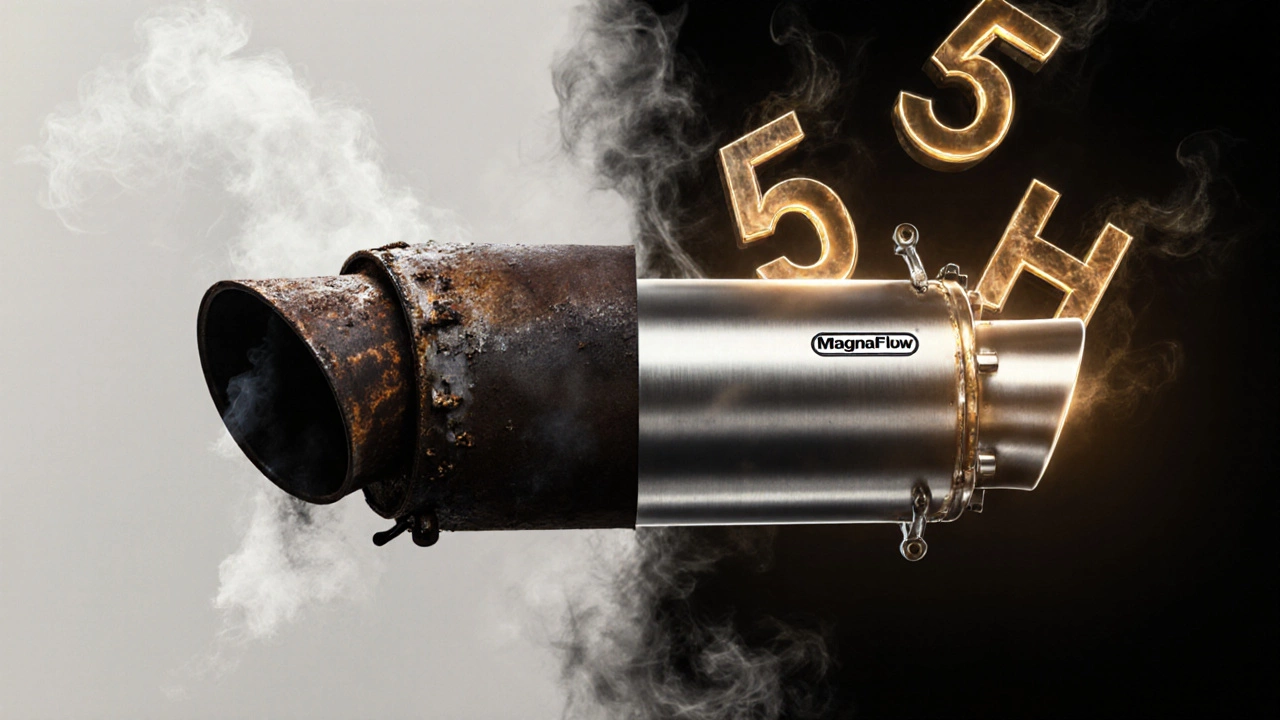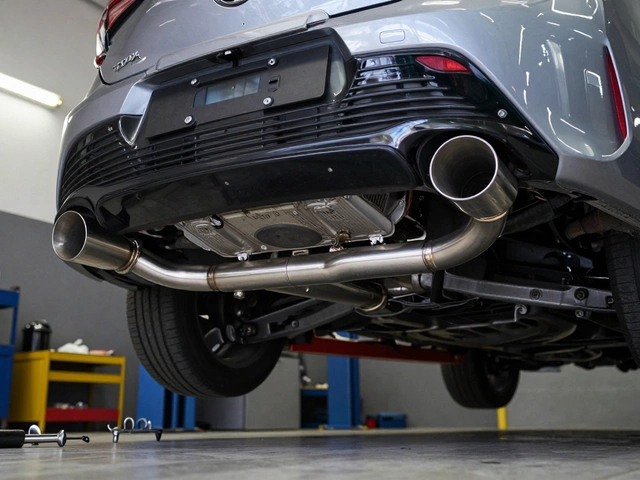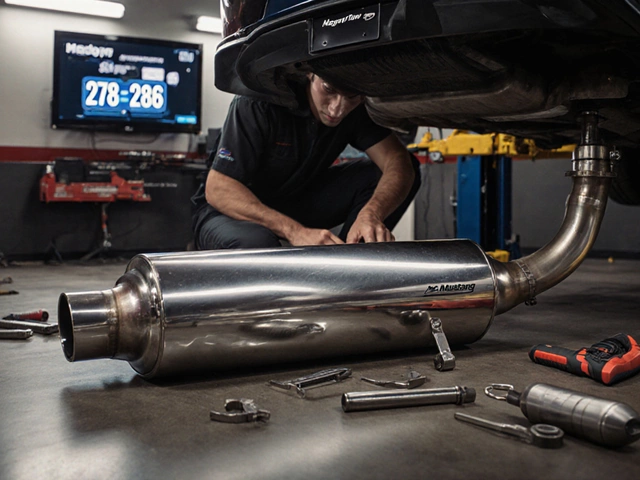MagnaFlow Horsepower Gain Calculator
Estimate Your Potential Gain
How much horsepower might you gain with a MagnaFlow muffler upgrade?
Many car owners buy a MagnaFlow muffler hoping for a noticeable boost in horsepower. They see the sleek stainless steel design, hear the deep rumble, and assume more power comes with the sound. But does it actually deliver? The truth isn’t as simple as yes or no.
What a MagnaFlow muffler actually does
A MagnaFlow muffler isn’t a performance chip or a turbocharger. It’s a straight-through, stainless steel exhaust component designed to reduce backpressure. Unlike traditional mufflers with baffles and chambers that restrict airflow, MagnaFlow uses a perforated core wrapped in fiberglass insulation. This lets exhaust gases flow more freely out of the engine.
Reducing backpressure helps the engine breathe better. When exhaust can exit faster, the engine doesn’t have to work as hard to push gases out. That efficiency can translate into small power gains - but only under the right conditions.
How much horsepower can you really gain?
Independent dyno tests from sources like Car and Driver and MotorTrend show that replacing a stock muffler with a MagnaFlow typically adds between 5 and 10 horsepower. That’s not nothing, but it’s not a game-changer either. For a 250-horsepower V6, that’s a 2-4% increase. For a 400-horsepower V8, it’s barely noticeable on the road.
Here’s the catch: if your stock exhaust system is already free-flowing, the gain drops to 1-3 horsepower. Many modern cars come with decent exhaust setups from the factory. Upgrading just the muffler on those models won’t move the needle much.
Big gains happen when you replace the entire exhaust system - from the headers to the tailpipe. A full system upgrade can add 15-25 horsepower, depending on the engine. But that’s not just a muffler swap. That’s a $1,500+ project.
Why people think they gain more power
It’s easy to believe you’re faster after installing a MagnaFlow. The sound changes dramatically. The deep, throaty tone makes the car feel more aggressive. Your brain links that sound with performance. You press the gas harder. You shift later. You drive more spiritedly. Suddenly, it feels like you’ve gained power - even if the numbers haven’t changed.
There’s also confirmation bias. People who buy performance parts tend to notice every small improvement. They remember the time they accelerated faster on the highway. They forget the 10 other times the car felt exactly the same.
What actually matters for horsepower gains
If you want real horsepower from your exhaust, focus on these three things:
- Backpressure reduction - MagnaFlow helps here, but only if your stock system is restrictive.
- Exhaust diameter - A 2.5-inch pipe flows better than a 2-inch pipe. Most stock systems are undersized.
- Header upgrade - Headers are the #1 way to improve exhaust flow. A MagnaFlow muffler won’t fix poor header design.
Replacing just the muffler on a car with stock headers and narrow piping is like putting new tires on a bike with a broken chain. It helps, but it doesn’t fix the core problem.

Who benefits most from a MagnaFlow muffler?
Not everyone gains the same amount. Here’s who sees the best results:
- Owners of older cars (pre-2010) with factory mufflers that are clogged or rusted.
- Drivers of naturally aspirated V6 or V8 engines - these engines respond well to reduced backpressure.
- People who drive aggressively and rev their engines frequently.
- Those who want a deeper, more refined exhaust note without the drone of cheaper aftermarket options.
On the flip side, owners of turbocharged engines, small 4-cylinders, or modern cars with factory performance exhausts won’t see much difference. Turbo engines rely on exhaust pressure to spool the turbo. Too much flow can hurt low-end response.
Real-world test: 2018 Ford Mustang V6
A 2018 Ford Mustang V6 came with a factory exhaust that had a restrictive resonator and a small-diameter muffler. After installing a MagnaFlow muffler (part number 15890), a local shop ran it on a dyno. Results:
- Stock: 278 horsepower, 262 lb-ft torque
- With MagnaFlow: 286 horsepower, 267 lb-ft torque
That’s an 8-horsepower gain - and a noticeable improvement in throttle response above 3,500 RPM. The sound went from muffled to rich and muscular. No drone at highway speeds. No check engine light. The owner said it felt like the car finally had its voice back.
What about fuel economy?
Some people buy MagnaFlow mufflers hoping for better gas mileage. The reality? You might see a 1-2% improvement in highway driving if you drive calmly. But if you enjoy the new sound and drive harder, you’ll likely use more fuel. The efficiency gain is real, but it’s easily erased by your right foot.

Is it worth the money?
A MagnaFlow muffler costs between $200 and $400, depending on your vehicle. Installation runs another $100-$200. For a 5-10 horsepower gain and a better sound, many owners say yes. It’s one of the most affordable, low-risk upgrades you can make.
Compare that to a cold air intake ($300-$500) or a tune ($400+). Those can give you more power, but they’re riskier. A tune can void your warranty. A cold air intake can let in water and hydrolock your engine. A MagnaFlow muffler? It’s plug-and-play. No tuning needed. No risk of damage.
What you should do before buying
Before you hand over your cash, ask yourself:
- Is my current muffler rusted, damaged, or excessively restrictive?
- Do I care more about sound than raw horsepower?
- Am I willing to pay $300+ for a modest power gain?
- Have I checked if my car’s factory exhaust is already performance-oriented?
If you answered yes to the first two, you’re a good candidate. If you’re chasing big power gains, look at headers, a full exhaust system, or a tune instead.
Bottom line: It’s a sound upgrade with a side of power
A MagnaFlow muffler won’t turn your daily driver into a track monster. But it can give you a noticeable, reliable boost in horsepower - usually 5-10 HP - if your stock exhaust is outdated. More importantly, it delivers a rich, satisfying exhaust note without the annoying drone that plagues cheaper alternatives.
It’s not a magic bullet. But for the price, it’s one of the most satisfying upgrades you can make to a gasoline-powered car. If you want more power, go bigger. If you want a better sound and a small, honest gain in performance, a MagnaFlow muffler is a solid choice.
Does a MagnaFlow muffler make your car faster?
It makes your car feel faster, but the actual speed gain is small - usually 5-10 horsepower. That’s enough to improve throttle response and make passing easier, especially on highways. It won’t improve 0-60 times significantly unless you have a heavily modified engine.
Will a MagnaFlow muffler hurt my engine?
No. MagnaFlow mufflers are designed to reduce backpressure, which actually helps engine efficiency. They’re made from stainless steel and built to last. As long as you install it correctly and don’t remove other emissions components, it won’t damage your engine or trigger a check engine light.
Do I need to tune my car after installing a MagnaFlow muffler?
No. Unlike air intakes or performance chips, a MagnaFlow muffler doesn’t require a tune. It’s a passive upgrade that works with your factory ECU settings. You can install it and drive away the same day.
Is a MagnaFlow muffler louder than stock?
Yes, but not obnoxiously loud. It gives your car a deeper, more resonant tone - like a well-tuned sports car. Unlike some cheap mufflers, MagnaFlow doesn’t produce annoying drone at highway speeds. It’s aggressive without being rude.
Can I install a MagnaFlow muffler myself?
Yes, if you have basic tools and some mechanical experience. Most installations take 1-2 hours. You’ll need jack stands, a wrench set, and possibly a reciprocating saw to cut the old muffler. Follow the manufacturer’s instructions carefully. If you’re unsure, pay a shop to do it - it’s worth the peace of mind.


